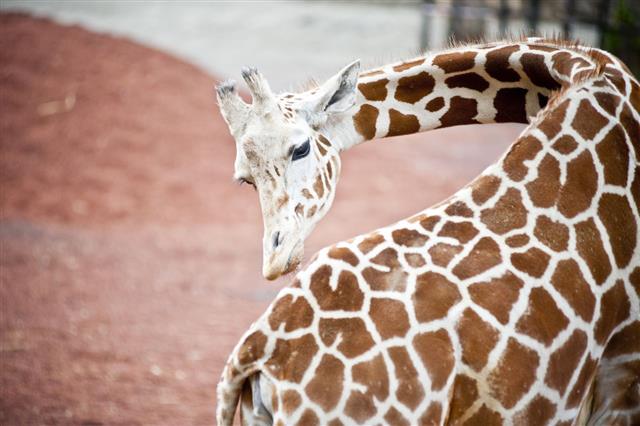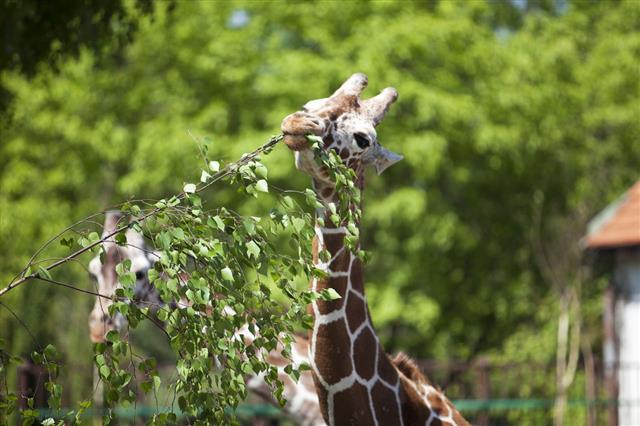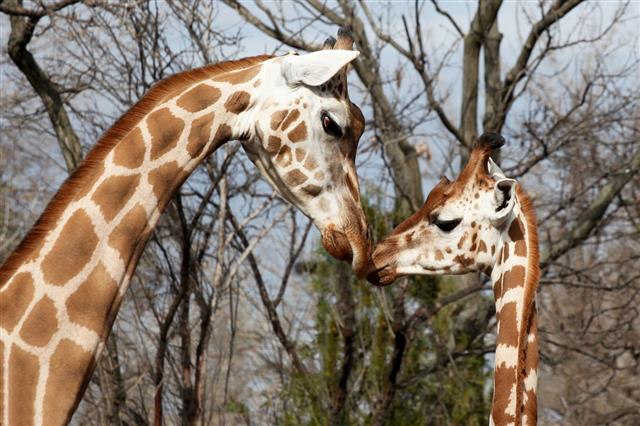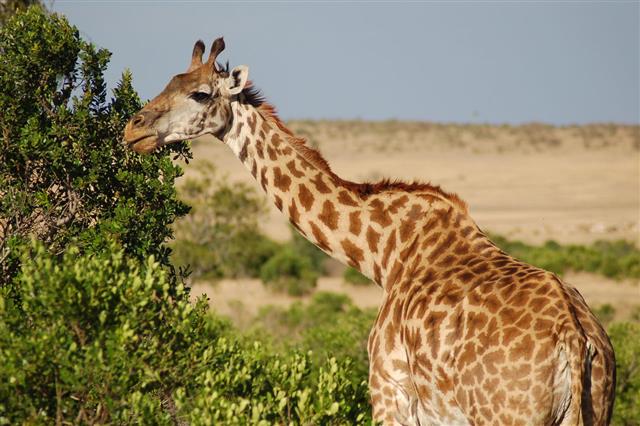
Were you aware that each time a giraffe lifts up its neck, it lifts more than 550 pounds? If that made you gape in wonderment, then read on for more such intriguing facts about giraffes!
There are so many interesting things to learn about giraffes that you’ll never tire of reading about them! Their dignified appearance, combined with the poise and grace that they exhibit, makes them one of the most darling animals in the world. In this article, we’ll touch upon some rather interesting facts about giraffes, concerning their physiology, habitat, diet and lifestyle.
The Basics
The name giraffe is derived from the Arab word zarafa, which means ‘the one who walks very fast’.
The scientific name of the giraffe is Camelopardalis. The etymology of this name can be traced to a belief (which is untrue) that the giraffe was a cross between a camel (height) and a leopard (coat pattern).
A male giraffe is called a bull, a female is called a cow, and a baby giraffe is called a calf.
The species has only nine members. These including the Camelopardalis or Nubian mentioned above, are – Reticulated, Angolan, Kordofan, Masai, Rhodesian, Baringo/Rothschild/Ugandan, South African and West African/Nigerian.
The average life span of a giraffe in the wild is between 20 to 25 years.
Giraffes usually move in groups of about 30 – 35 individuals, usually mothers and their offspring. Males tend to get more solitary as they age and are generally not a part of a group.
Giraffe Physiology
The tallest living animal on land, the giraffe stands at about 18 feet in height while its shoulders stand at 8 feet.
An adult male giraffe weighs between 3,400 lbs – 3,600 lbs, while the female weighs between 1,600 lbs – 2,000 lbs. A giraffe’s heart weighs between 24 lbs – 26 lbs and is approximately 2 feet in length.
Although giraffes have to support a neck that is between 6 – 8 feet in length (almost 18 times the length of a human neck!), they have the same number of cervical vertebrae as that of a human being, i.e. seven!
Both, male and female giraffes have small horn-like structures called ossicones. Females and baby giraffes have a small tuft of hair/fur on the ossicones, while males tend to be bald.
Sometimes, the extreme height can prove to be a bit cumbersome. Ever seen a giraffe drinking from a waterhole? They have to get into a pretty awkward position by spreading their front legs apart and bending their neck downward, which makes them extremely vulnerable to predators.
Giraffes have the highest recorded blood pressure. 280/180mm Hg on average.
They have elastic blood vessels in their necks, which makes it possible for them to bend their neck to the ground and lift it again, without fainting.
When they sleep, which is for a measly 30 minutes a day, they fold their forelegs beneath them, turn their neck towards their back and rest it on their rump. Sleeping while standing is also recorded.
Reproduction and Care of the Young
Giraffes can conceive after the age of 5 years. Delivery takes place in the standing position. The calf falls headfirst to the ground from a height of about 5 to 6 feet!
Males evaluate the fertility of females by tasting their urine! Males usually prefer young/middle-aged females for reproducing with, rather than the mature or juvenile ones.
The gestation period of giraffes is around 14 months.
A calf is capable of running within a few short hours after being born.
A newborn giraffe stands approximately 6 feet tall. After it is born, its ossicones, which were flattened in the womb, become erect.
The usually very peaceable females will engage in fights to protect their young ones if they feel they are threatened.
When it comes to taking care of the young, giraffes rely on teamwork. One female looks after the young of the entire herd, while the others go around foraging for food.
Eating Habits
Giraffes are herbivorous animals. They enjoy eating different types of leaves and grass, a special favorite being the thorny acacia leaves.
Their unusually long neck helps them reach the high branches of trees to feed on the leaves. In addition to the long neck, they are further equipped with a really long tongue, which measures around 20 inches, which helps them reach branches that seem just out of reach after stretching their neck.
Giraffes have a black colored tongue and antiseptic saliva! Together with the thick lips, the teeth and the tongue do a good job of protecting the giraffe’s mouth from the prickly thorns on trees.
They are ruminant mammals. This means that they first swallow all the food that they wants (generally more than 30 kg a day) after some perfunctory chewing, and then bring up the half-digested cud back up to the mouth later, to chew on again.
Even though giraffes can consume large quantities of food, if circumstances are extreme they can also survive on a bare minimum of just 6 kg!
A giraffe can go for a long stretch of time without water, just like a camel. Their water needs are met by the high water content in the vegetation that they consume.
Lifestyle of a Giraffe
Neck wrestling matches, called ‘necking’, are often held to show authority in their herds. Males participate in these ‘authority’ matches. The violent versions are also pretty tame in keeping with their nature, and they make up after by caressing or mounting each other!
Giraffes are social animals, and they live in open herds. When there is abundant foliage on the trees in the forests, giraffes scatter around to enjoy it. However, once winter approaches and food begins to become scarce, they congregate and live together to collectively look for food.
Giraffes are silent animals, but they are certainly not mute. Sounds similar to those emitted by cows and goats have been recorded from giraffes too. While males make coughing sounds to attract females, females bellow to call out to their young! The little ones can mew, bleat, moo and snort!
Giraffes have color vision. They are blessed with excellent eyesight. This helps them keep an eye on each other from a distance and also to survey the area for predators.
Lions and large packs of hyenas are the giraffe’s only predators. Their long and strong legs are helpful in safeguarding them from these predators. A single, full-forced kick from a giraffe can seriously injure and sometimes even kill a fully grown lion!
Random Facts about Giraffes
Giraffes running at top speed can reach a maximum of around 55 to 60 km/h, that too, intermittently.
They sleep for hardly half an hour a day, and even this sleep is divided into 5 or 10 minute naps.
Each giraffe has a unique coat pattern and it has been observed that giraffes of a herd seem to have similar coat patterns.
A giraffe’s age can be calculated from its spots. The darker the spots, the older the giraffe.
Same-sex coupling has been observed in giraffes. The incidents of such activities are much higher amongst males (usually occurring after ‘necking’), than amongst females.
Although it is believed that they cannot cough, scientists have discovered that males emit a coughing sound in order to attract females for mating.
While walking, giraffes use legs on the same side for each step. Meaning, they walk using the front and hind legs of the same side. Every step a giraffe takes is almost 15 feet in length.
Tanzania has honored the giraffe by naming it their national animal.
Although giraffes were hunted pretty extensively many years ago and also driven away from their habitats for various reasons. Some of the subspecies are endangered though and are listed as ‘Vulnerable’ by the IUCN.
These fascinating creatures are probably as peace-loving as they come. Although they usually mind their own business when not bothered, they can be formidable when threatened. The more one finds out about these gentle giants, the more endearing they become!



































